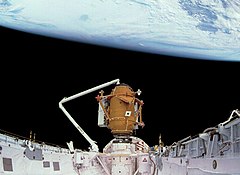Mir Docking Module

The docking module seen in the payload bay of the Space Shuttle Atlantis on STS-74, prior to docking with Mir.
|
|
| Station statistics | |
|---|---|
| Part of: | Mir |
| Launch date: | 12 November 1995 |
| Launch vehicle: |
Space Shuttle Atlantis (STS-74) |
| Docked: | 15 November 1995 |
| Reentry: | 23 March 2001 |
| Mass: | 4.3 metric tonnes |
| Length: | 4.7 metres |
| Diameter: | 2.9 metres |
| References: | |
| Configuration | |
 The docking module shown isolated in its basic configuration. Various additional external fixtures are not shown.
|
|
The Stykovochnyy Otsek (Russian: стыковочный отсек, English: Docking compartment), GRAU index 316GK, otherwise known as the Mir docking module or SO, was the sixth module of the Russian space station Mir, launched in November 1995 aboard the Space Shuttle Atlantis. The module, built by RKK Energia, was designed to help simplify space shuttle dockings to Mir during the Shuttle-Mir programme, preventing the need for the periodic relocation of the Kristall module necessary for dockings prior to the compartment's arrival. The module was also used to transport two new photovoltaic arrays to the station, as a mounting point for external experiments, and as a storage module when not in use for dockings.
The docking module originated in the 1992 design version of the cancelled Mir-2 space station, which featured a combined docking compartment and airlock to facilitate docking missions during the Soviet Buran space shuttle programme (this module, SO-1, was eventually incorporated into the Russian Orbital Segment of the International Space Station as Pirs). When the Shuttle-Mir programme began, engineers realised that in order to enable US space shuttles to dock to Mir, the Kristall module would have to be relocated to the forward port of the core module and back to its own lateral port each time a shuttle docked, a process which was not only time consuming but would also be entirely reliant on Kristall's Lyappa arm, which, should it fail, would prevent any further shuttle missions to the station. Adding a small extension to Kristall, however, would provide the shuttles the clearance they needed to dock without necessitating the relocation of the module on each occasion, and it was decided to base the design of the new module loosely on that of the Mir-2 docking compartment.
...
Wikipedia
